Plan checklist
South Portage Dock
1415 South Portage Road, Lake Of Bays
Planting plan created by The District Municipality of Muskoka
Schedule A:
Plants & Property
Land Characteristics
This planting plan is designed based on the land characteristics identified during the day of the site visit. Plants are chosen according to the soil and light conditions on your property. The number of plants chosen for each planting compartment takes into account the square metre area of the space, as well as the amount of current vegetation cover. Your property is part of ecoZone: 5b
Land Characteristics by Compartment
| Length | Width | Area | pH | Soil | Moisture | Light | Height | |
|---|---|---|---|---|---|---|---|---|
| A | 19.8m | 4.5m | 89.1m2 | acidic | sandy | normal | full sun | max 3m |
| B | 7.9m | 3m | 23.7m2 | acidic | sandy | normal | full sun | max 3m |
| C | 7.1m | 2m | 14.2m2 | acidic | sandy | normal | full sun | max 2m |
| 34.8m | 3.17m | 127m2 |
Plant Selection Summary
The following shrubs and trees are chosen for their suitability and survivability given the current soil and light conditions in each compartment on your property, as well as preferable features.
| Plant Species | A | B | C | Potted | Bareroot | Wildflower |
|---|---|---|---|---|---|---|
| Snowberry | 9 | 9 | ||||
| Shining Willow | 3 | 3 | ||||
| Sweet Gale | 2 | 2 | ||||
| Gray Dogwood | 2 | 2 | ||||
| Saskatoon Serviceberry | 2 | 2 | ||||
| Red Osier Dogwood | 2 | 2 | ||||
| Steeplebush | 6 | 6 | ||||
| Narrow Leaved Meadowsweet | 6 | 6 | ||||
| Bush Honeysuckle | 5 | 5 | ||||
| Chokecherry | 1 | 1 | ||||
| Black Chokeberry | 2 | 2 | ||||
| Staghorn Sumac | 4 | 4 | ||||
| Fragrant Sumac | 6 | 6 | ||||
| Subtotal | 40 | 4 | 6 | 50 | 0 | 0 |
| Totals | 50 | |||||
Plant Information
The following table summarizes key information about each plant selected for your property.
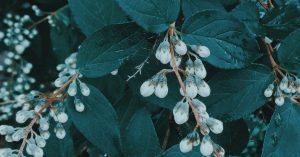
|
SnowberryHeight: 1-2m
The Snowberry is a small shrub known for its white berries bunching at the nodes. This species produces oval-shaped, oppositely arranged, dark green colored leaves with smooth margins on short stalks. The shrub grows 1-2m in height. This shrub yields white to pink clusters of bell-shaped flowers during the summer. The fruiting bodies produced by this shrub are small, white berries that grow in bunches. These berries provide a good food source to a variety of animals, but are poisonous to humans. Snowberry is an ideal species for bank stabilization applications because its roots are vigorous and deep ranging. .
|
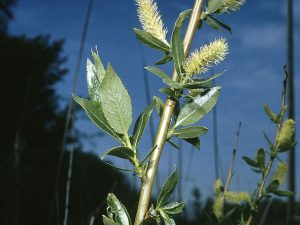
|
Shining WillowHeight: 10m
The Shining Willow is a relatively large deciduous shrub, which grows up to 10 m in height. The shiny leaves are 5-11 cm long and 1-5 cm wide, which are what give this Willow its name. They are lance shaped, with dark green color on the top, and light green on the bottom. Flowers bloom from May to June and range in colour from yellow to a green/brown.
|
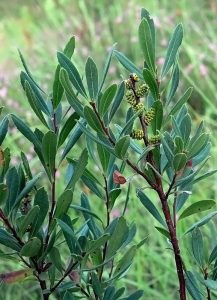
|
Sweet GaleHeight: 1-2m
Sweet Gale is a medium-sized shrub which grows into a thick bush about 1-2 m tall. This species produces 1-8 cm long, oblong-lanceolate leaves which are finely toothed at the tip and are spirally arranged. When bruised, these leaves give off a pleasant aroma. Male and female catkins are produced on separate plants. The seeds are dispersed from the female plants via water, as they float on two corky bracts. This shrub also provides a good food source for bird species that eat the seeds including Grouse, Chickadees, and Bluebirds. Mammal species like Beavers and White-Tailed Deer also browse on the twigs and leaves of this plant.
|
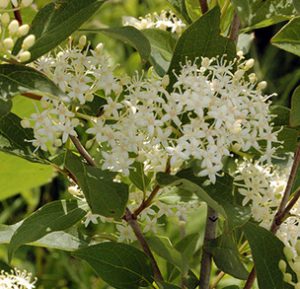
|
Gray DogwoodHeight: 2-3m
The Gray Dogwood, also referred to as Northern Swamp Dogwood or Panicle Dogwood, is a medium-sized, deciduous shrub which typically grows 2-3m. This species is multi-stemmed, with a full, round form. The leaves are green and arranged alternately along the branches. During the fall, leaves turn a bright red to deep purple colour. Between May and June, showy clusters of small white flowers bloom. These flowers turn into white fleshy berries late in the summer. The reddish-pink stems hold the berries throughout the winter, creating an artful contrast to the gray bark and snowy scenery. The Gray Dogwood is tolerant of a variety of environmental conditions and its complex, fibrous root system make it an ideal plant to use for controlling erosion.
|
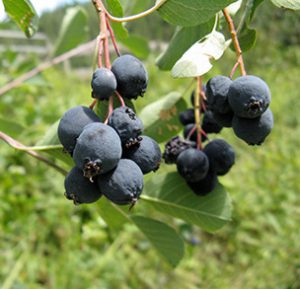
|
Saskatoon ServiceberryHeight: 5m
The Saskatoon Serviceberry is a very hardy, deciduous shrub, which grows numerous lateral and ascending branches giving it a full, rounded shape reaching heights of 5m. Early during the spring, slender pink buds open into small five-petaled flower clusters on the terminal ends of the branches. The flowers open prior to the leaf bud development, turning the plant into a showy, white bush. Over the summer months, the flowers develop into small, pea-sized purple berries. Leaves produced are blue-green, oval-shaped, toothed prominently along the top of the leaf, and arranged alternately along the branches. During autumn, the foliage changes to yellowish-orange or a deep red-purple colour. The Saskatoon Serviceberry is an ideal species to stabilize banks, control erosion, and restore natural areas due to its fibrous root system.
|
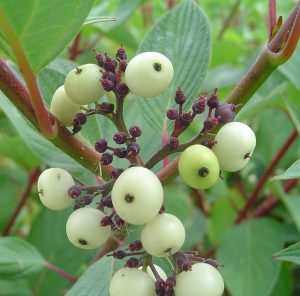
|
Red Osier DogwoodHeight: 1.5-4m
The Red Osier Dogwood is a medium-sized, deciduous shrub native throughout Northern and Western North America which typically grows to 1.5-4m. This species is multi-stemmed with numerous erect and ascending bright red branches that create a loose and spreading form. Leaves produced are simple, two-toned with a dark green upper side and light green underside. They are arranged opposite each other along the branches. During the fall, the foliage turns a brilliant red to dark purple. Clusters of small, creamy white flowers form on the terminal ends of the branches between June and July. The Red Osier Dogwood produces blueish-white fruiting bodies during late summer, which may persist throughout the winter. This shrub's berries provide an important winter food source for numerous species, from large deer to small wintering birds.
|
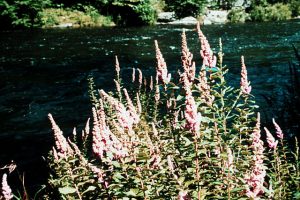
|
SteeplebushHeight: 1 m
The Steeplebush is a deciduous shrub species that typically grows about 1 m in height . This plant may also be known by the common names: Rose Spiraea or Hardhack. The leaves are dark green, about 7 cm long, elliptic to ovate shaped, have toothed margins, and have dense yellowish brown hairs on the undersides. The flowers are tiny, rose pink to purplish coloured, bloom in late summer, and appear on tall, dense, steeple shaped clusters. This plant is useful for controlling erosion and stabilizing shorelines. The flowers are also beneficial for pollinator species, like bees and butterflies.
|
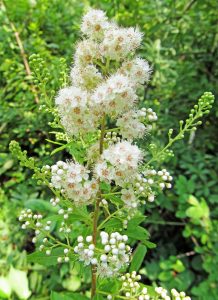
|
Narrow Leaved MeadowsweetHeight: 1-2m
The Narrow Leaved Meadowsweet is an erect, deciduous shrub, which grows in the shape of a mound to a height of 1-2m. This species develops numerous branches and branchlets, giving it a sparse appearance. Leaves produced are simple and narrow with sharply toothed borders growing alternately along the branches. These bright, light green leaves appear crowded, as they grow close together on the stocks and branches. During the fall, leaves turn a yellow-red or yellow-orange colour. Small white to light pink flower clusters appear in the spring growing in a dense, narrow pyramid at the terminal ends of the branches. During late summer to early fall, these flowers produce smooth, papery seed pods.
|
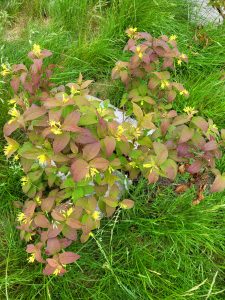
|
Bush HoneysuckleHeight: 1m
The Bush Honeysuckle is a small, hardy, deciduous shrub that rarely grows taller than 1 m in height. The leaves are simple, oppositely arranged, ovate shaped, and have finely toothed margins. During the spring and summer, the leaves are dark green in colour, then in the fall they take on a variety of colours ranging from a deep purple to light yellow. The flowers are small, showy, yellow to orange colored, trumpet shaped, appear in clusters on the tips of branches, and bloom between June and July. The flowers are beneficial to pollinator species, including hummingbirds and butterflies. The roots of the Bush Honeysuckle are fibrous, giving it the ability to form thickets and making it an ideal shrub to plant for erosion control.
|
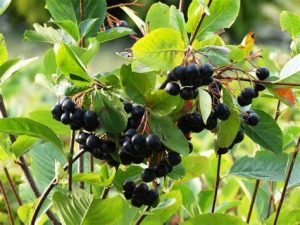
|
ChokecherryHeight: 6-9 m
The Chokecherry is a large deciduous shrub or small tree which grows between 6 and 9 m tall and is a member of the Rose family. It produces a twisted or crooked trunk as well as a narrow, oval to round crown composed of many slender branches. Leaves are alternately arranged, simple, have a deep green upper surface, and light matte green undersides with tufts of hair at the vein axils. During the fall, foliage turns a vibrant deep red to fire yellow or orange. Between May and June, small showy white flowers grow in cylindrical clusters on the terminal ends of branches. By mid-August, flowers turn into shiny deep red or black cherries, which hang in elongated clusters. The fruit is ripe by September and provides a food source for birds and small mammals. The Chokecherry is often found as pure stands forming thickets, or mixed with other early succession shrub and tree species. This fast-growing plant can quickly invade logged land, abandoned farms, and exposed shorelines. The fibrous and wide-spreading root system of this shrub make it an ideal plant for erosion control and bank stabilization. This species possesses the ability to withstand moderate flooding and drought.
|
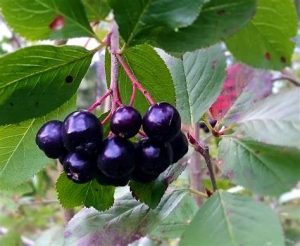
|
Black ChokeberryHeight: 1-3m
The Black Chokeberry is a medium sized deciduous shrub that typically grows between 1-3m with edible fruit. This species requires full sun to partial shade and can tolerate soil conditions from loamy and moist to rocky and dry. Naturally, Black Chokeberry is found in wet wooded areas such as; swamps, along shorelines, and within forest understory. This species is multi-stemmed, and forms thickets from stems which arise from the roots. Leaves are simple, growing alternately along the branch turning a bold red to orange during the fall. During spring, clusters of showy, white flowers appear turning into dark purple berries by fall. This species is resistant to drought, insects, pollution, and disease. The Black Chokeberry is often cultivated as an ornamental plant and food product. Additionally, this species is useful for bank stabilization and erosion control applications.
|
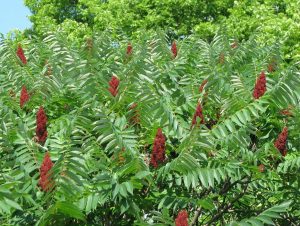
|
Staghorn SumacHeight: 4-8m
The Staghorn Sumac is a hardy, wide spreading shrub species which typically grows 4-8m. The name is derived from its thick branches that resemble the antlers of a male deer or a stag. This species produces compound leaves which can contain up to 31 serrated, feather-like leaflets with an opposite arrangement. These leaves turn a rich red during autumn. The Staghorn Sumac produces cone-like clusters of small yellow/green flowers, which give way to crimson red berries that are covered in fine hairs. The Staghorn Sumac is easily recognized by its branches which are covered in fine hairs resembling velvet. The trunk of this species is normally branchless, until it opens up into a short, wide crown at the top. The branches also secrete a pale milky sap when broken. Staghorn Sumac is a highly tolerant species and may be found in open areas along roadsides, shorelines, and forest edges.
|
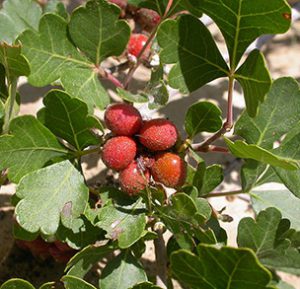
|
Fragrant SumacHeight: 1-2m
The Fragrant Sumac is a medium-sized deciduous shrub within the Cashew family. This species grows between 1-2 meters in height, is multi-stemmed, and produces a round, dense crown composed of erect and spreading branches. Between March and April, small yellow flower clusters bloom on the terminal ends of the branches prior to leaf development. Fruit development begins during late summer. Small, red, hairy berries are produced and can remain on the plant throughout the winter. Male catkins develop on the plant in September. Fragrant Sumac leaves are simple and arranged alternately along the branch. Leaves produced are simple and trifoliate with a large center lobe, appearing similar to Poison Ivy. During the spring and summer, the leaves are light green to green-yellow in colour turning a bright yellow to red or dark purple in autumn. Crushed leaves and stems of the Fragrant Sumac produce a fragrant citrus aroma, hence the common name. The aroma of this shrub is attractive to butterfly species, making it the perfect addition to any butterfly garden. The roots of the Fragrant Sumac are shallow, fibrous, and spread rapidly, making it an ideal choice for stabilizing shorelines and mitigating erosion on steep slopes. Unlike other Sumac species, Fragrant Sumac is significantly less aggressive and easily maintained.
|
Compartment A
Naturalization Area
Runoff from the road pH: acidic
pH: acidic Depth: potted
Depth: potted-
 Moisture: normal
Moisture: normal -
 Soil Type: sandy
Soil Type: sandy  Plant Height: max 3m
Plant Height: max 3m-
 Light conditions: full sun
Light conditions: full sun
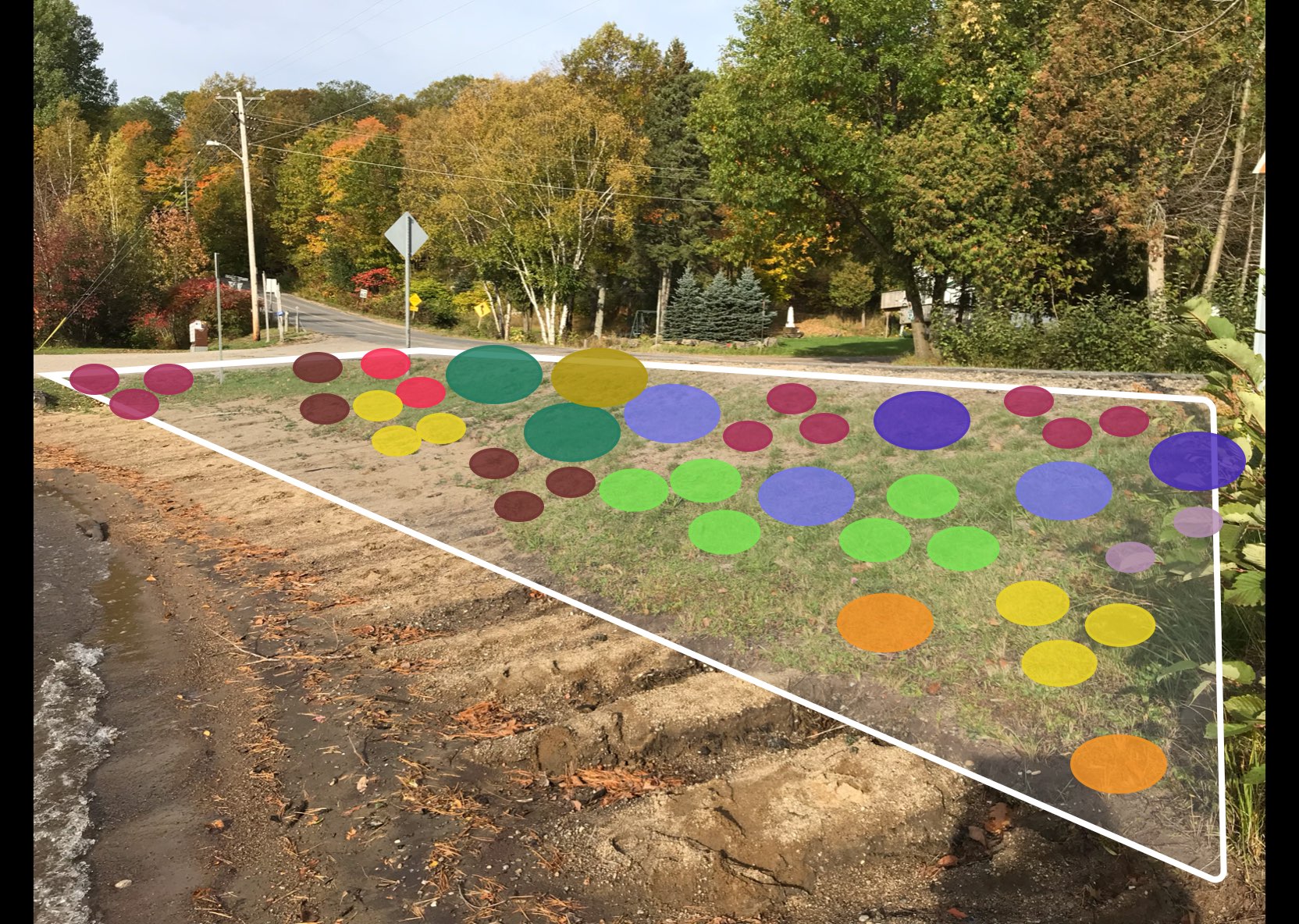
Compartment B
Naturalization Area
 pH: acidic
pH: acidic Depth: potted
Depth: potted-
 Moisture: normal
Moisture: normal -
 Soil Type: sandy
Soil Type: sandy  Plant Height: max 3m
Plant Height: max 3m-
 Light conditions: full sun
Light conditions: full sun
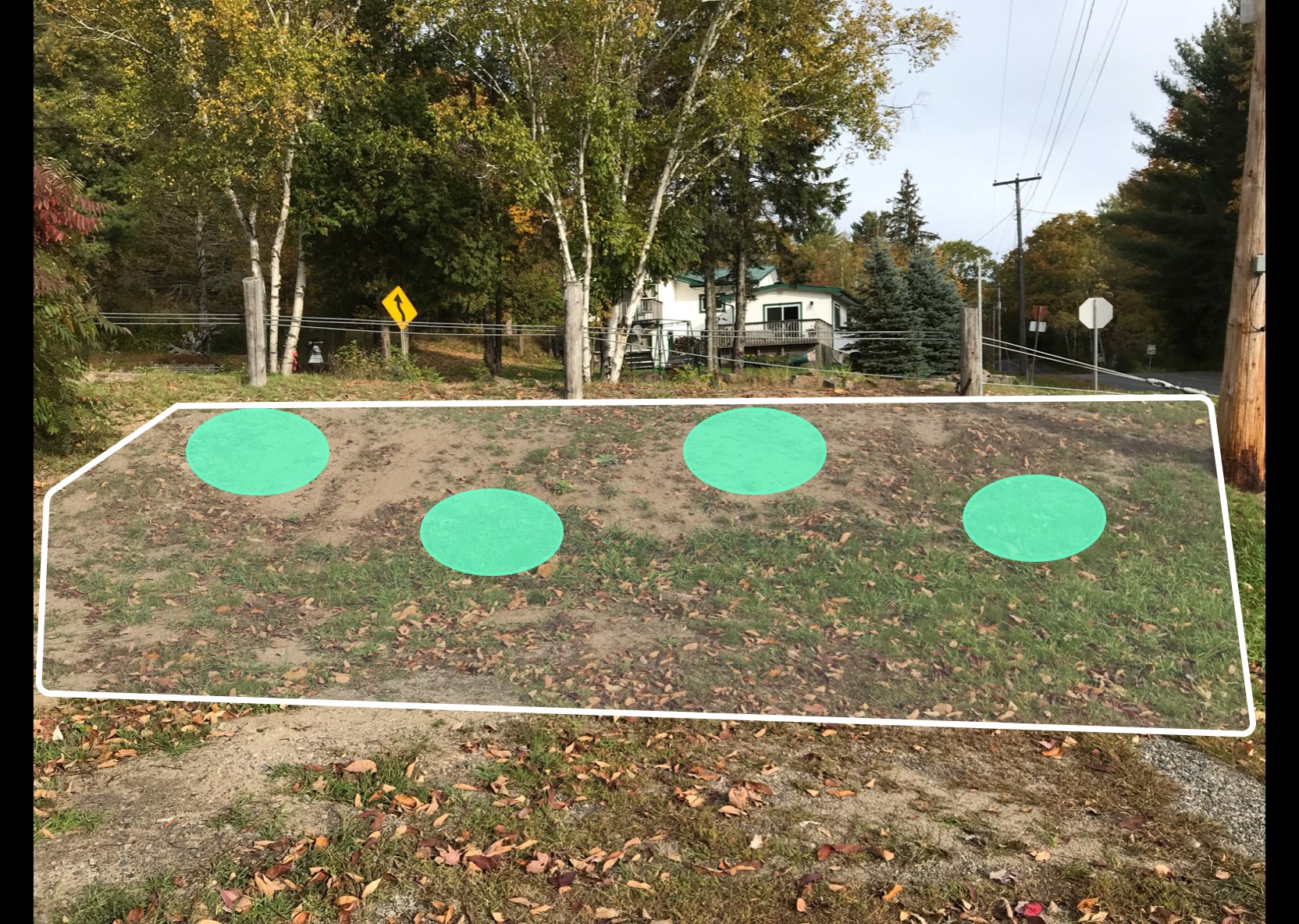
Compartment C
Naturalization Area
 pH: acidic
pH: acidic Depth: potted
Depth: potted-
 Moisture: normal
Moisture: normal -
 Soil Type: sandy
Soil Type: sandy  Plant Height: max 2m
Plant Height: max 2m-
 Light conditions: full sun
Light conditions: full sun
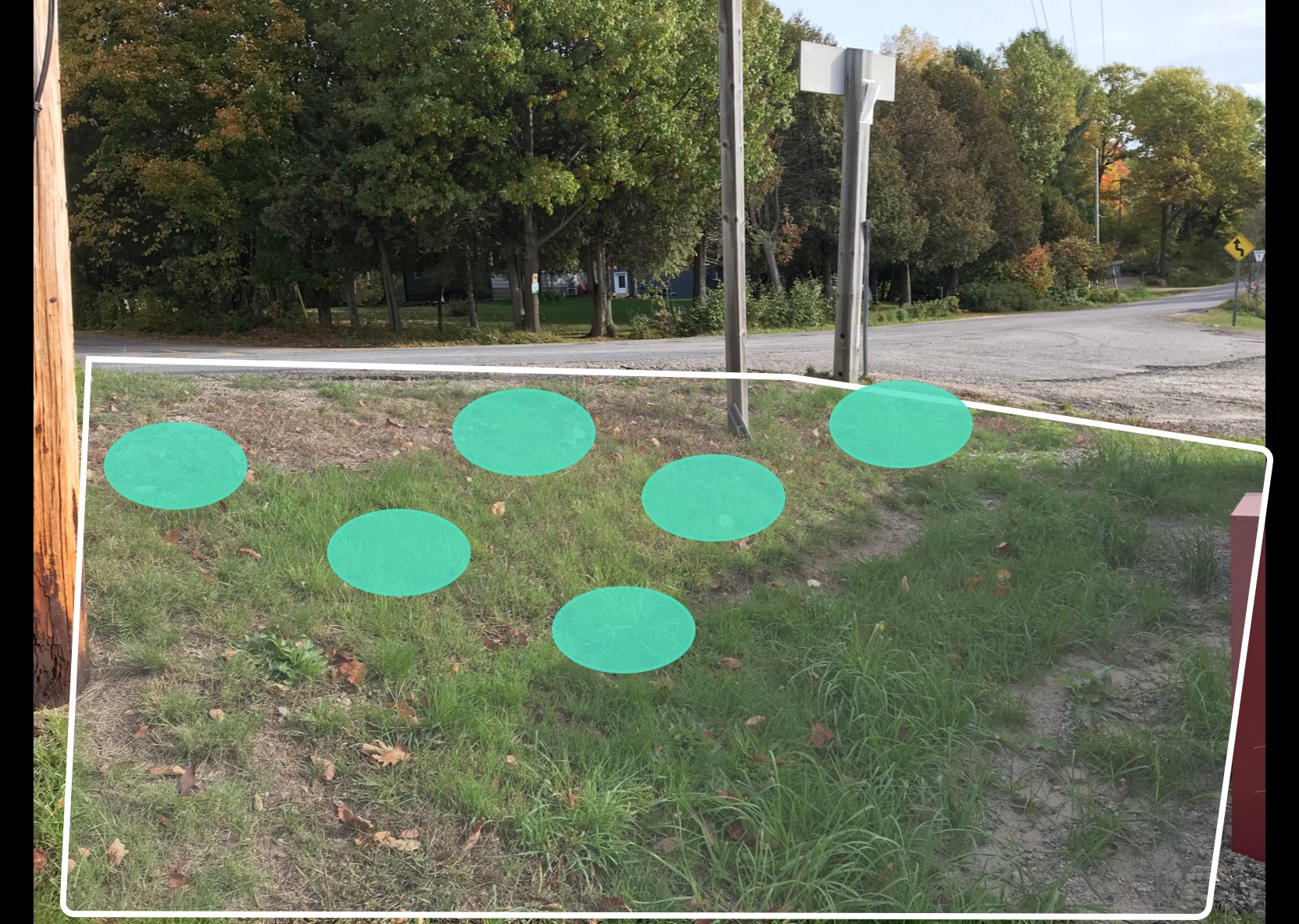
Schedule B
Financial Summary
Project by: The District Municipality of Muskoka
Shoreline Re-Naturalization Starter Kit includes: free site visit, customized re-naturalization planting plan for your shoreline property, native plants including free bare root (small) and potted (large) plants and wildflowers, coconut fibre pads to deter grass from growing around new plantings, tree guards for all deciduous trees, mulch for your wildflowers, Plant Care Guide with instructions on how to take care of your new plants, Habitat Creation Guide and a Wildflower Garden Guide.
Our planting plans are created onsite with you and provide detailed information and plans to re-naturalize your shoreline property. We take photos of areas for planting and overlay native plants that are well suited to your property based on site conditions such as soil type and sunlight availability.
We will work with you to create a plan that works for you including options for low growing plants in areas where views are important.
| Item | Quantity | Cost/Item | Subtotal |
|---|---|---|---|
| Starter Kit fee | $300 | ||
| Free potted plants | 20 | $0 | $0 |
| Paid potted plants | 30 | 12.00 | 360.00 |
| Free bareroot plants | 0 | $0 | $0 |
| Free wildflowers | 0 | $0 | $0 |
| Total costs | 660.00 |
Schedule C
Project Agreement
Stewardship Agreement
Please indicate your agreement to this proposed plan by signing the following Stewardship Agreement and submitting it, along with your financial contribution, to:
The District Municipality of Muskoka
70 Pine Street
Bracebridge, Ontario
P1L 1N3
Plant Availability
Please note that plant species may need to be changed based on plant stock availability at the time of ordering.
Project Completion
Upon receiving your signed stewardship agreement and financial contribution, a date will be booked for you to pick up your Natural Edge Kit. The District Municipality of Muskoka will supply all plants and materials. If you are paying for the planting to be completed for you, a date will be arranged for The District Municipality of Muskoka to plant your shoreline, bringing the plants and materials with them. If there are particular dates that you would prefer, we will do our best to accommodate your requests.
The Natural Edge Stewardship Agreement with The District Municipality of Muskoka
Agreement made this Day of the Month of in the Year .
BETWEEN Township Of Lake Of Bays 1415 South Portage Road Lake Of Bays Ontario (Hereinafter called the OWNERS)
AND The District Municipality of Muskoka 70 Pine Street Bracebridge, Ontario P1L 1N3 (Hereinafter called DMM)
WHEREAS the Owners and DMM have met and discussed plans for shoreline naturalization on the specified area(s) in Schedule A existing on the Owners’ land;
WHEREAS the Owners indicate approval of the project as proposed; and
WHEREAS the project is, or will be for the benefit of the Owners and others;
NOW THEREFORE THE PARTIES AGREE AS FOLLOWS:
1. This Agreement shall be in effect for a period of 5 years, commencing with the date of this Agreement.
2. The Owners and DMM agree that the areas where the work is to be performed is as described in Schedule A.
3. The Owners agree to pick up their Natural Edge Starter Kit from DMM’s office and plant their shoreline within two days of receipt. The Owners will provide “after” photos of the work completed to be used for reporting purposes. If the Owners wish to have the planting completed for them, then DMM or it’s contractors, employees and agents will complete the planting at cost, as indicated in Schedule B.
4. If the planting is to be completed by DMM, then the Owners grant DMM, its contractors, employees and agents, the right to enter the property to perform the work agreed upon as outlined in Schedule A. In addition, DMM, its contractors, employees and agents may inspect the work performed for the purposes of monitoring the project and survival assessment, with prior agreement with Owners for date and time of inspection.
5. The Owners agree to contribute the “Landowner contribution” and pay the costs indicated in Schedule B.
6. In instances where the Owners are to pay DMM for work to be performed (outlined in Schedule A), the Owners agree to provide payments to DMM prior to the commencement of that operation. Failure of payment shall constitute a breach of this Agreement and the Owners agree that this Agreement will be terminated and thereupon the Owners agree to pay DMM the estimated costs of the operations of the project completed to date, if any.
7. The Owners agree, if necessary, to perform a reasonable amount of maintenance, which is described in the Native Plant Care Guide, available at naturaledge.watersheds.ca.
8. If a contractor is required to perform the work outlined in Schedule A, then the contractor carrying out the work on the land described will be required to take out and furnish evidence of a comprehensive policy of public liability and property damage coverage. The contractor and their workers will be required to be in good standing with the Workplace Safety and Insurance Board (WSIB) prior to performing the work.
9. The Owners agree not to remove, destroy or alter the project without prior consultation and approval of DMM. Pruning and trimming planted nursery stock, or adding replacement native nursery stock is exempt.
10. The Owners agree not to mow the planted area.
11. The Owners do acknowledge that DMM, its contractors, employees and agents, having performed said works, are not under further obligation with respect to survival of nursery stock, inspection, or maintenance.
12. The Owners, in the absence of negligence, hereby remise, release and forever discharge DMM, its contractors, employees and agents from all claims and demands for injuries, including death, loss, damages and costs in any way related to or connected with installation and maintenance of the work described or resulting from any deleterious effects of the work to the land or to the lands and buildings thereon retained by the Owners.
IN WITNESS WHEREOF the parties have agreed to the contents of this plan; SIGNED:
About this program
About The District Municipality of Muskoka
The District of Muskoka is an upper-tier municipality that has monitored water quality in Muskoka area lakes since 1980. Since 2002, the Muskoka Water Strategy has provided integrated and strategic initiatives for the protection of Muskoka's water resources. The purpose of the strategy is to guide and minimize the impact of human activities on water resources; ensure human and environmental health; and preserve the quality of life in Muskoka.
This program was created by Watersheds Canada
We believe that every person has the right to access clean and healthy lakes and rivers in Canada. At Watersheds Canada, we work to keep these precious places naturally clean and healthy for people and wildlife to continue using for years to come. We love working with others to meet the needs of local communities, whether you’re a concerned citizen, a landowner, a lake association looking for help, or a coalition of groups interested in activating your local community.

